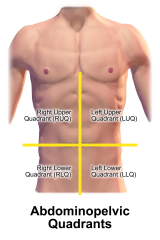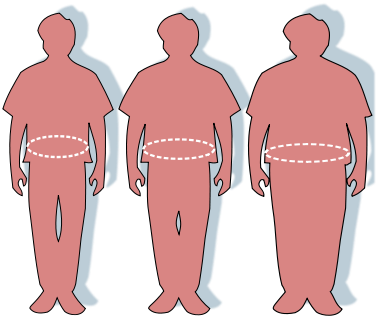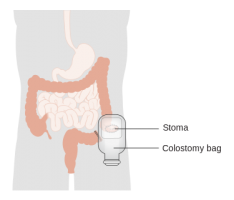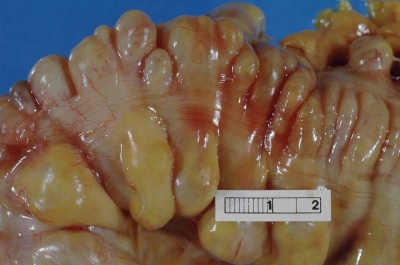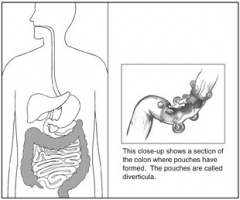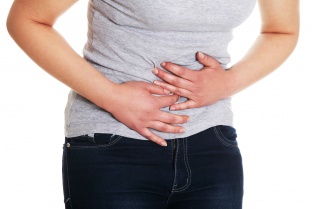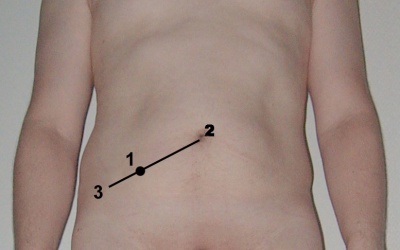Diverticulitis
Top Contributors - Katie Countryman, Cate Hurst, Khloud Shreif, Lucinda hampton, Elaine Lonnemann, Kim Jackson, WikiSysop, Karen Wilson, 127.0.0.1 and George Prudden
Introduction[edit | edit source]
Colonic diverticulitis is a complication of colonic diverticulosis, and one of the presentations of diverticular disease. Colonic diverticulosis refers to the presence of multiple tiny pouches, or diverticula, in the colon.. Differentiating one from the other is important as uncomplicated diverticulosis is mainly asymptomatic whilst acute diverticulitis is a potentially life-threatening illness.[1]
The most common symptoms of diverticulitis include severe left lower quadrant abdominal pain, marked changes in bowel habits, fever, and nausea. Possible complications include perforation of bowels, abscess formation, fistula formation, obstruction, and bleeding.
Diverticulitis diagnosis is typically confirmed with the presence of constitutional symptoms, bloody stools, elevated white blood cell count, and with the use of imaging studies.[2] Depending on the severity of the condition, diverticulitis can be treated with rest, changes in diet or antibiotics, and in severe cases may require surgery.[3]
Epidemiolgy[edit | edit source]
Diverticulitis is a complication of diverticulosis, and the demographics of the condition much alike. Elderly patients are most at risk. 4% of people with diverticulosis go on to develop diverticulitis.[1]
Etiology[edit | edit source]
Colonic diverticular development may involve involve bowel wall abnormality, increased intraluminal pressure, and lack of dietary fibre. Diverticulitis is the result of obstruction of the neck of the diverticulum (outpouch), with consequential inflammation, perforation, and infection. A walled of region of soft tissue may later progress to abscess formation and generalised peritonitis.[1]
Risk Factors include: Increased age; Constipation; Sedentary lifestyle; Obesity; Smoking; NSAIDS; Red meat[4]
Characteristics/Clinical Presentation[edit | edit source]
The presentation and signs and symptoms can vary for each individual patient. Although many of the patients have the same side effects, they are usually experienced at different intensities and at various times. Some of the most common signs and symptoms that are present with the diverticulitis diagnosis include the following[2]:
- Sudden abdominal pain usually in LLQ - cramping, bloating, tenderness, but can still occur on the right
- Palpable mass
- Irregular bowel movements
- Bowel sounds absent or decreased
- Flatulence
- Fever
- Nausea/ Vomiting
- Bloody stools
- Increased frequency of urination
Associated Co-morbidities[edit | edit source]
Risk Factors[4]:
- Increase age
- Constipation
- Sedentary lifestyle
- Obesity
- Smoking
- NSAIDS
- Red meat
Diverticulitis is more common as the person ages and if the person is overweight. Increasing the amount of exercise that is done each day has shown less of a risk for being diagnosed with diverticulitis. Patients who smoke and /or drink heavy amounts of alcohol have a higher chance of developing diverticulitis than those who do not. Certain medications, such as NSAIsS, steroids, and opiates put a person more at risk for developing this problem[4]. When looking at diet, if people do not get enough fiber, this could lead to decreased bowel movements, causing constipation.[4].
In acute diverticulitis, patients can get an abscess or blockage in their colon or small intestine from the scarring that took place during the episode. Fistula, an abnormal connection between two body parts, can also form between the colon and bladder or vagina, leading to a medical emergency[4]. Another medical emergency is if a person gets peritonitis, which occurs when contents of the intestine get into the abdomen from a ruptured inflamed pouch. Quick attention is necessary for the patient to begin fighting a possible infection.
Treatment[edit | edit source]
Treatment depends on a range of factors, in p-articular comorbidities and stage of the disease.
- Localised disease: conservative management with intravenous antibiotics and rehydration usually is enough.
- Surgery may be required if a patient has a complication (abscess, fistula formation, bowel obstruction), has had multiple episodes of uncomplicated diverticulitis, or is immune-compromised. Surgery may be recommended or it may require emergency surgery[1]. There are two main types of surgery[3]: Primary bowel resection/laparoscopic procedure; Bowel resection with colostomy[4].
Diagnostic Tests/Lab Tests/Lab Values[edit | edit source]
Diverticulitis is typically diagnosed during an acute attack due to complaints of severe abdominal pain. Due to the prevalence of abdominal pain in a number of conditions, the physician may order a number of tests to rule out other causes of abdominal pain and associated symptoms.[3]
Systemic Involvement[edit | edit source]
Diverticulitis can cause problems in some of the systems in the body. The main system that is involved is the Gastrointestinal system. That is because the lining of the intestines and colon develop pouches that can progressively get larger, bulge out, and cause a possibility of a rupture[5].
This can cause serious bleeding problems or infection[3]. If the rupture happens multiple times, scarring can form leading to possible blockage for feces to pass[3].
Medical Management[edit | edit source]
Asymptomatic diverticulitis requires no medical management or treatment.[4] Uncomplicated diverticulitis typically is treated with bowel rest (or clear liquids), antibiotics, and pain control. Antibiotic treatment may be given on an outpatient basis for 7-10 days for patients with stable vitals, absence of fever, and no significant results on CT or laboratory values. Treatment is 70-100% effective in patients with uncomplicated diverticulitis.[3]
Patients who have diverticulitis with complications (25% of patients), other health conditions, or have had multiple attacks (one-third of patients) may require surgery. Currently, laparoscopically surgery is performed on case-by-case basis with good outcomes reported.[4]
Emergency surgery is necessary within 48 hours for patients who have a ruptured intestine, peritonitis, or severe symptoms.[6] Hospitalization is suggested for patients with radiographic abnormalities, fever, and leukocytosis. Symptoms should improve within 2-3 days when diverticula start to heal. Failure to improve warrants revaluation with a CT and other laboratory tests.[4]
Four-six weeks following resolution of symptoms, a colonoscopy may be suggested to verify the presence of diverticulitis and to rule out colon cancer.[3]
Prevention of diverticulitis is from a variety of lifestyle changes. Adherence to a high-fiber diet, decreased red meat intake, prevention of constipation with an adequate balance of fluids and fiber intake, cessation of smoking, and regular exercise during remission may decrease the risk of diverticulitis.[4]
Physical Therapy Management[edit | edit source]
As a physical therapist, the optimal goal is to help a patient return moving in a functional way. Being active helps decrease the chances of developing diverticulitis because movement helps promote proper bowel movement. Therapists can help patients with proper exercise, strengthening, and positioning to help them get the best and safest movement possible. Patients with diverticulitis must be cautious about doing activities that increase the pressure on their abdomen so further herniation does not happen[2].
Exercise can be seen as a protective mechanism because it is promoting movement to the body, but also the different systems that could be affected from a sedentary lifestyle[2]. Depending on the symptoms that the patients present with, it is up to the therapist to do appropriate screening or testing to identify what is involved and what is causing the issues.
A common area of pain is the left lower quadrant, including referred pain to low back or thigh from an abscess[7]. For example, the obturator test, manual muscle testing and palpation of the illiopsoas ,or McBurney’s point palpation can be done to look at positive or negative testing of referred pain to the thigh[2][7].
Differential Diagnosis[edit | edit source]
Differential diagnosis of diverticulitis can include many different areas of the body.
- Gastrointestinal disorders, such as inflammatory bowel disease, constipation, appendicitis or a hernia can cause abdominal pain[2].
- Genitourinary problems, such as inflamed prostate or urinary tract infection are possible[7].
- Gynecological problems, including ectopic pregnancy, miscarriage, hemorrhage, ovarian cyst, or malignancy are other possible problems[7].
- Vascular issues, such as aneurysms or vasculitis could occur[7].
- An abscess in the abdominal wall or psoas can all be a possible diagnosis when presenting with similar symptoms as diverticulitis[7].
- Ehlers-Danlos, Marfan Syndrome, and Scleroderma are all connective tissue disorders that are shown to be similar to diverticulitis[2].
- Diverticulitis can also be a genetic disorder where there can be a defect in the intestine wall[4].
Case Reports/ Case Studies[edit | edit source]
- Schattner A, Klein Y, Herskovitz P. An atypical presentation of a common disease. QJM. 2011;105(9):891-893.
- Caecal diverticulitis, an uncommon mimic of appendicitis. Case Reports. 2013;2013(feb06 1):bcr2012007820-bcr2012007820.
- Tsalis K. Cecal Diverticulitis is a Challenging Diagnosis: A Report of 3 Cases. Am J Case Rep. 2015;16:206-210.
Resources[edit | edit source]
- National Institute of Diabetes and Digestive and Kidney Disease[8]
- Merck Manual - Diverticulitis[9]
- U.S. National Library of Medicine - Diverticulitis[6]
- Polish Medical Center- Diet for Diverticulitis[10]
References[edit | edit source]
- ↑ 1.0 1.1 1.2 1.3 Radiopedia Colonic diverticulosis Available:https://radiopaedia.org/articles/colonic-diverticulosis?lang=gb (accessed 22.1.20230
- ↑ 2.0 2.1 2.2 2.3 2.4 2.5 2.6 Goodman CC, Snyder TE. Differential diagnosis for physical therapists: screening for referral. 4th ed. St. Louis: Saunders Elsevier, 2007.
- ↑ 3.0 3.1 3.2 3.3 3.4 3.5 3.6 MCS. Diverticulitis Disease and Condition [Internet]. - Mayo Clinic. 2014 [cited 2016Mar31]. Retrieved from: http://www.mayoclinic.org/diseases-conditions/diverticulitis/basics/definition/con-20033495
- ↑ 4.00 4.01 4.02 4.03 4.04 4.05 4.06 4.07 4.08 4.09 4.10 Goodman CC, Fuller KS. Pathology: implications for the physical therapist. 3rd ed. St. Louis: Saunders Elsevier, 2009.
- ↑ What I need to know about Diverticular Disease [Internet]. National Institute of Diabetes and and Digestive Kidney Disease; 2012 [cited 2016Apr1]. Retrieved from: http://www.niddk.nih.gov/health-information/health-topics/digestive-diseases/diverticular-disease/pages/ez.aspx
- ↑ 6.0 6.1 Diverticulitis: MedlinePlus Medical Encyclopedia [Internet]. Nlm.nih.gov. 2016 [cited 7 April 2016]. Available from: https://www.nlm.nih.gov/medlineplus/ency/article/000257.htm
- ↑ 7.0 7.1 7.2 7.3 7.4 7.5 Hammond N. Left Lower-Quadrant Pain: Guidelines from the American College of Radiology Appropriateness Criteria. American Family Physician. 2010;82(7):766-770.
- ↑ Stollman N, Smalley W, Hirano I. American Gastroenterological Association Institute Guideline on the Management of Acute Diverticulitis. Gastroenterology. 2015;149(7):1944-1949.
- ↑ Diverticulitis [Internet]. Merck Manuals Consumer Version. 2016 [cited 7 April 2016]. Available from: http://www.merckmanuals.com/home/digestive-disorders/diverticular-disease/diverticulitis
- ↑ Milewska M. Dietary prevention and treatment of diverticular disease of the colon. Polish Medical Journal [Internet]. 2015 [cited 8 April 2016];38(226):228-232. Available from: http://medpress.com.pl/pubmed.php?article=226228
